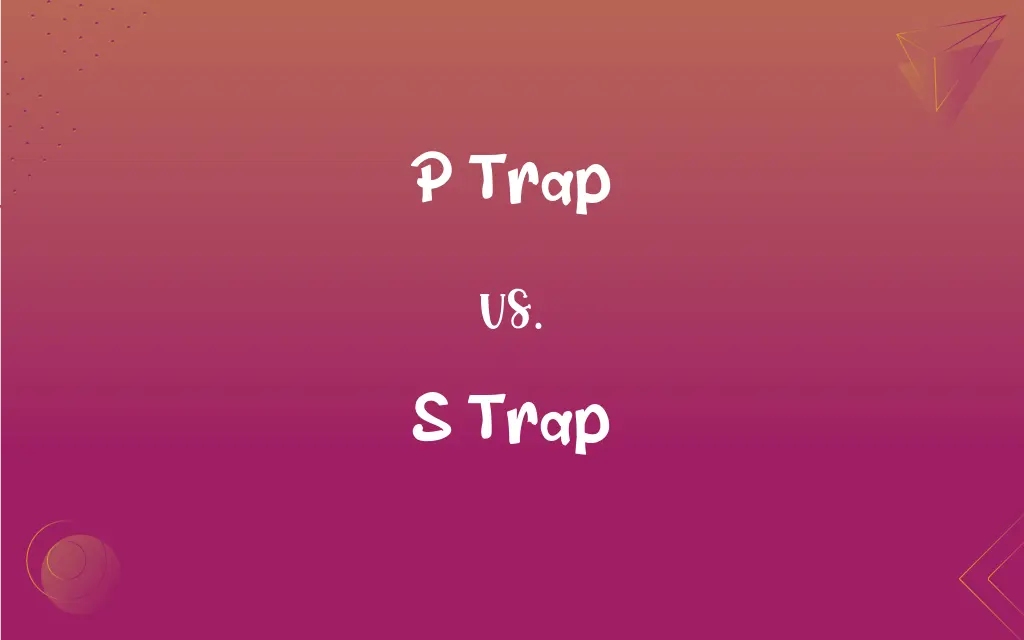P Trap vs. S Trap: What's the Difference?
Edited by Janet White || By Harlon Moss || Updated on October 11, 2023
P traps have a U-shaped bend and S traps have an S-shaped bend; both are plumbing devices designed to keep a small amount of water to prevent sewer gases from entering the building.

Key Differences
The P trap features a P-shaped configuration that combines a horizontal overflow pipe with a U-shaped trap, becoming a key component in maintaining hygienic conditions in a living space by sealing the sewer odors. The S trap, on the other hand, showcases an S-shaped design that effectively provides a water seal, with its design commonly found in floor-mounted toilet installations and often considered in settings where the waste outlet penetrates the floor, thereby offering a practical solution in these specific installations.
In terms of application, the P trap is predominantly used in modern plumbing systems, especially where the plumbing exits the wall, ensuring a reliable and efficient mechanism for safely evacuating waste water while retaining a necessary water seal. The S trap, although functional, has become less common in modern plumbing in some regions due to potential issues with siphonage that could compromise the water seal, and it is used primarily where the plumbing exits through the floor.
The P trap offers an advantage in reducing the risk of siphoning the trap dry, which is a pivotal aspect in sustaining a consistent water barrier between the indoor environment and the unwanted gases from the sewer system. The S trap, however, due to its more direct path from the inlet to the outlet, is sometimes more susceptible to siphonage, which can inadvertently allow sewer gases to permeate living spaces if the water seal is compromised.
From a regulatory standpoint, P traps are widely accepted and utilized in various plumbing codes and installations due to their efficacy and reliability in maintaining the water seal. Conversely, S traps are not permitted in some locales or under certain plumbing codes because their design can occasionally lead to problematic siphonage, resulting in the potential for sewer gases to infiltrate indoor spaces.
When considering repairs and replacements, P traps often provide a straightforward process due to their widespread use and availability in various materials and sizes. S traps, while potentially more challenging to locate in some areas due to diminished use, remain relevant and available for replacements or installations where their specific design is deemed necessary or preferable.
ADVERTISEMENT
Comparison Chart
Shape
U-shaped bend
S-shaped bend
Common Application
Wall exit plumbing
Floor exit plumbing
Siphonage Risk
Lower
Higher
Regulatory Acceptance
Widely accepted
Limited/Restricted
Modern Usage
Common
Less common
ADVERTISEMENT
P Trap and S Trap Definitions
P Trap
P traps retain water to form a seal against sewer gases.
The P trap always holds water, creating an effective barrier.
S Trap
S traps are traditionally used in floor-exit plumbing.
The toilet, with its floor drainage, utilizes an S trap for waste removal.
P Trap
P traps are widely accepted in various plumbing codes.
Most building regulations approve the use of a P trap in plumbing systems.
S Trap
S traps might not be permitted under certain plumbing codes.
The plumber noted that the use of S traps is restricted under some local codes.
P Trap
P traps are available in different materials and sizes.
When replacing the P trap, ensure to select one of appropriate size and material.
S Trap
S traps are less commonly used in modern plumbing applications.
Despite being less prevalent, S traps can still be found in specific plumbing installations.
P Trap
The P trap features a P-shaped pipe configuration.
The P trap under the sink helps prevent sewer gases from entering the home.
S Trap
S traps can be susceptible to siphonage, compromising the water seal.
If siphonage occurs, the S trap might lose its water seal, enabling gas entry.
P Trap
P traps are commonly utilized in wall-exit plumbing.
For wall-drain configurations, a P trap is often the preferred choice.
S Trap
S traps feature an S-shaped pipe configuration.
S traps are designed to prevent sewer gases from rising by maintaining a water seal.
FAQs
What happens when the water seal in a P trap or S trap is lost?
If the water seal is lost, sewer gases can enter the building.
Are S traps illegal or just not recommended in some places?
S traps are not permitted under certain plumbing codes due to the risk of siphonage.
When replacing a P trap, what considerations should be made?
Considerations should include the size and material of the P trap and ensuring a secure and leak-free connection during installation.
Are there any alternatives to the S trap that provides floor exit plumbing without the siphonage issue?
An alternative to the S trap for floor exit plumbing might be using a P trap with an additional horizontal pipe to reach the floor-level exit.
What issues might arise if an S trap loses its water seal?
If an S trap loses its water seal, it may allow unpleasant and potentially harmful sewer gases to enter the living space.
Can the material of the P trap affect its functionality?
While the material of the P trap does not directly impact its fundamental function, different materials can offer varying durability and resistance to corrosion.
How often should a P trap require replacement or maintenance?
P traps may require occasional maintenance for leaks and might need replacement if corroded or damaged.
In what scenarios might an S trap be the preferred or only option?
S traps might be preferred or the only option in some older plumbing setups where the waste outlet penetrates the floor.
How does the design of the P trap prevent backflow of sewer gases?
The P trap’s U-shaped bend retains a standing water barrier that prevents the backward passage of sewer gases into the building.
How can I prevent the water in my P trap from evaporating over time?
Regular use typically prevents P trap evaporation, but in unused drains, occasionally adding water can prevent seal loss.
Why is the P trap more widely accepted in plumbing codes?
The P trap is widely accepted because its design is less prone to siphonage, maintaining a consistent water seal against sewer gases.
Can an S trap be converted to a P trap?
Yes, an S trap can often be converted to a P trap with additional piping, altering the waste outlet direction.
What materials are commonly used to manufacture P traps?
P traps are commonly manufactured using PVC, ABS, brass, or chrome-plated brass.
What should be done if an S trap is not maintaining its water seal?
If an S trap is not maintaining its water seal, it may need to be checked for siphonage issues or be converted to a P trap if permitted.
What is the main function of a P trap?
The P trap maintains a water seal to prevent sewer gases from entering a building.
Why might S traps be considered less in modern plumbing?
S traps can be prone to siphonage, potentially breaking the water seal and allowing sewer gas entry.
Can P traps and S traps be used interchangeably?
They may not be directly interchangeable due to their differing shapes and application suitability.
How do I identify an S trap in my plumbing system?
An S trap can typically be identified by its S-shaped curve, where the waste outlet goes through the floor.
Why is the S trap still used if it’s prone to siphonage?
S traps may still be used in certain applications where floor drainage is needed and are prevalent in older installations.
In which installations might a P trap be more beneficial than an S trap?
P traps are typically more beneficial in installations where the plumbing exits through the wall, such as sinks and wall-drain toilets.
About Author
Written by
Harlon MossHarlon is a seasoned quality moderator and accomplished content writer for Difference Wiki. An alumnus of the prestigious University of California, he earned his degree in Computer Science. Leveraging his academic background, Harlon brings a meticulous and informed perspective to his work, ensuring content accuracy and excellence.
Edited by
Janet WhiteJanet White has been an esteemed writer and blogger for Difference Wiki. Holding a Master's degree in Science and Medical Journalism from the prestigious Boston University, she has consistently demonstrated her expertise and passion for her field. When she's not immersed in her work, Janet relishes her time exercising, delving into a good book, and cherishing moments with friends and family.































































